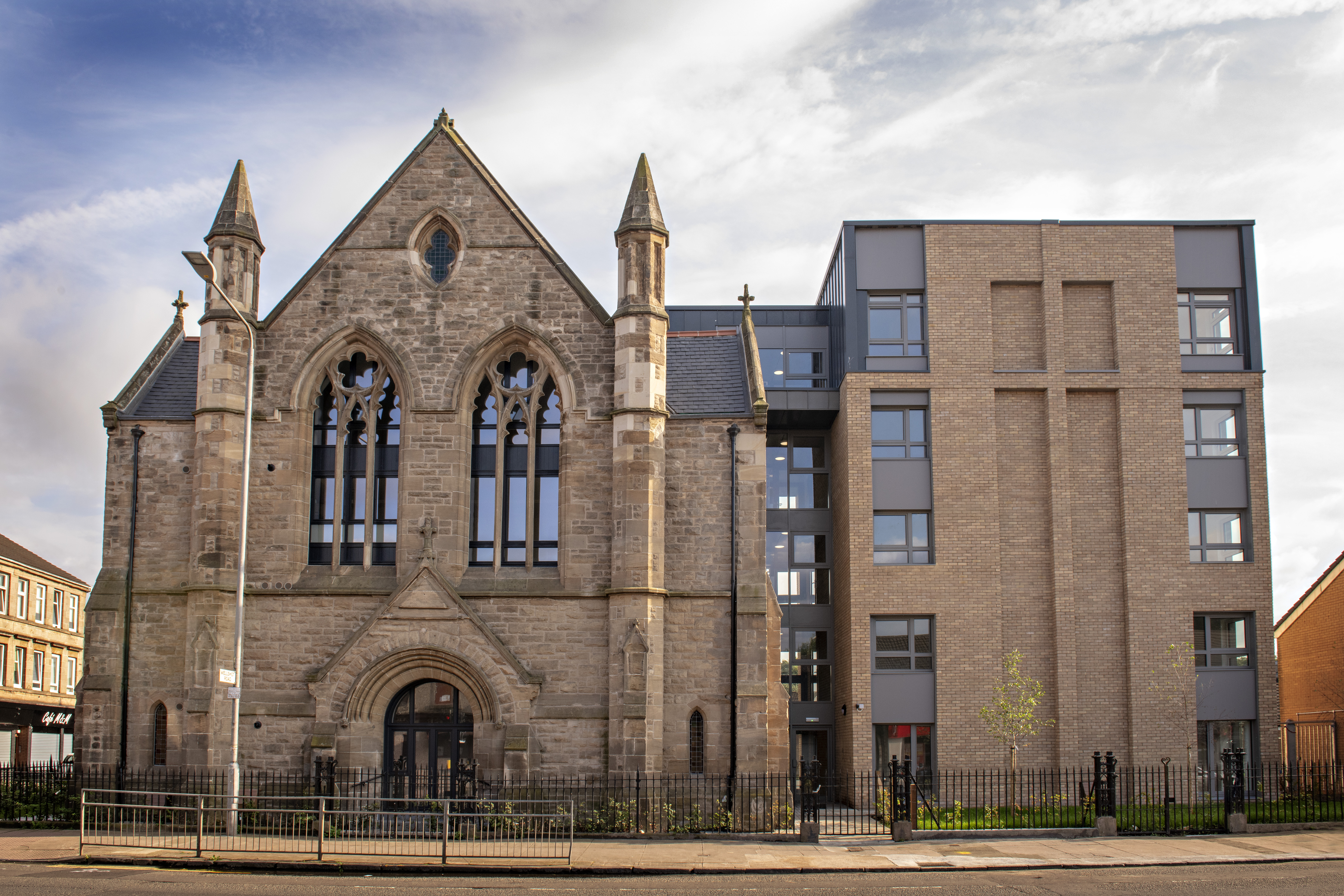Building Briefs – November 20th
- Shettleston development shortlisted for two UK awards
Shettleston Housing Association’s church conversion and Passivhaus development has been shortlisted in two categories in the national Inside Housing Awards.

Old Carntyne Church
Old Carntyne Church, in the east end of Glasgow, was transformed from a semi-derelict building into one of Scotland’s most energy-efficient affordable housing developments, including the city’s first multi-storey Passivhaus building.
This ambitious development has been selected as a finalist in the ‘Best affordable housing development (urban)’ and ‘Best older people’s housing development (up to 50 homes)’ categories.
The development, renamed Cunningham House, was built by contractor Stewart & Shields and designed by architects, Page\Park with John Gilbert Architects as Passivhaus Designer.
The redevelopment saw the conversion of the original church building into 13 amenity flats and a semi-detached 3-bed home with a glazed link to the five Passivhaus certified homes in the new five-storey tower. All 19 homes are designed and built to extremely high standards of energy efficiency, airtightness, and insulation.
Financial support for the project was provided by Glasgow City Council and the Scottish Government.
Winners will be announced at the Inside Housing Development Awards event on November 27 at the Intercontinental 02 Hotel in London.
- Glasgow considers compulsory purchase powers as part of empty homes strategy
Between 200-250 empty homes back into use annually over three years if Glasgow councillors approve the next stages of a new strategy.
A part of the wider Glasgow Housing Strategy, the proposed Empty Homes Strategy for the city aims to bring long-term empty homes back into use and was examined by a Glasgow City Council committee yesterday.
If approved, the strategy will see council officers aiming to bring between 200-250 empty homes back into use annually over three years. In addition, they will promote the reporting of empty homes in local areas to help develop a city-wide database of such properties. Compulsory purchase powers will be used, and the council will work with registered social landlords to provide assistance to buy empty homes through its acquisition strategy.
Glasgow currently has 2,687 homes listed as being empty for six months or more, and this figure does not include second homes.
The most common reasons for homes becoming empty for a long time include mortgage default and repossessions; deceased or untraceable owners; property title issues; and properties which have fallen into a poor state of repair.
Under the Housing (Scotland) Act 2010, local authorities can now use Council Tax records to identify vacant homes and bring them back into use, and from 2018, a surcharge of up to 100% Council Tax can be charged to owners of empty homes which are not being marketed for sale or rent.
Glasgow is the only Scottish local authority which alerts home owners prior to this application of the premium charge, with 433 owners notified of this up to eight weeks before it was applied.
The Glasgow Housing Strategy - now halfway through its five-year life - had set a target of 475-570 long-term empty homes being returned to use by end of that period, and this is ahead of schedule, with 380 homes now back in use, most of which are now socially rented.
The report will now be referred to the council’s city administration committee for a decision on approval.
- New kitchens for delighted Govanhill tenants

Glasgow-based contractor and manufacturer CCG has completed its latest phase of renewals with Govanhill Housing Association across various addresses in the south-Glasgow area.
Performed by the firm’s specialist planned maintenance division, CCG Asset Management, a total of 82 properties had full kitchen replacements, along with associated plumbing and decoration works, delivered within a period of just 11 weeks.
The contract is the latest to have been delivered by CCG on behalf of Govanhill Housing Association in 2019 which has also seen window replacements undertaken to residential properties as part of a full supply and install service [as a result of CCG’s window manufacturing capability] as well as a comprehensive major repairs contract that is currently being undertaken on Westmoreland/ Bowman Street.
- Glasgow unveils strategy to double number of city centre residents
A draft strategy which proposes how Glasgow’s city centre population will double in size to 40,000 over the next 15 years is to be open for public consultation.

At a growing figure of just over 20,000 people, Glasgow lies behind cities such as Manchester, Liverpool and Birmingham in terms of the numbers living and moving to live in the centre of those cities.
While Glasgow is now seeing a significant increase in both investor interest and planning approvals for private sector rent developments, the need to accelerate this trend has been identified through the City Centre Living Strategy (CCLS), which aims to establish a city centre population of 40,000 by 2035.
Glasgow City Council said it now considers population density to be crucial to the success and sustainability of city centres. These areas have traditionally been home to a thriving retail sector, and while Glasgow remains the biggest shopping destination in the UK outside of London’s West End, the rise of online shopping and shifting investor demand means that new uses have to be found for redundant floorspace, and residential development offers a good opportunity to repurpose this space.
The number of people living in UK city centres almost tripled between 2000-2011, as young, single and highly-educated millennials choose to live in urban areas and - while both Glasgow’s city centre strategy 2014-19 and city development plan have contributed to making a more mixed-use (combining leisure with retail) city centre that is more attractive as a residential location - the CCLS will further guide the growth of this population is Glasgow and the provision of all the supporting infrastructure and services that will be required.
The report highlighted the advantages Glasgow has over other city centres in terms of attracting a wide demographic to live there, but there are also challenges around meeting supply and demand for residential development, such as a high proportion of listed buildings (possibly difficult and expensive to convert) and pre-1945 properties.
A 10-week public consultation on the draft strategy will begin on November 29.
- Offshore wind’s thriving supply chain highlighted
Businesses working in Scotland’s offshore wind supply chain are highlighted in a new report published today to mark Offshore Wind Week (Nov 18-22).
Ports, fabricators, underwater vehicle specialists, helicopter transfer operators and more are featured, demonstrating the breadth and talent currently evolving to support this rapidly-expanding sector.
The document showcases a snapshot of 17 companies which were active in offshore wind in 2018-19, the majority of which are home-grown SMEs.
Claire Mack, Chief Executive of Scottish Renewables, which produced the report, told how it “demonstrates not just the current state of the offshore wind supply chain in Scotland but also the opportunities which come from diversifying into renewable energy”.
- Public exhibition for Berryden Corridor Improvement Project
A public exhibition is to be held for the Berryden Corridor Improvement Project in advance of planning permission being sought in the coming months.
The event, which will include Aberdeen City Council officers to enable the public to ask questions, is to be held in the Berryden area and is part of the process to keep the local community informed of the scheme.
The project will be a major upgrade to the city’s roads network as Berryden Road is currently operating beyond its capacity leading to significant congestion and journey time delays, particularly at peak times. It will improve the efficiency of the road, cycleway and pavement network through improving journey time reliability, relieving congestion and improving infrastructure for walking and cycling.
The improved road build on the benefits gained from the opening of Diamond Bridge, which has about 12,000 vehicles going over it daily relieving congestion at the Bridge of the Don and the Haudagain roundabout, while further improving connections within the city.
The Berryden Corridor Improvement Project is one of several major capital projects being undertaken by ACC as part of a £1 billion transformational programme across the city, including the Diamond Bridge, the AWPR B/T, the airport link road, the TECA complex, the Art Gallery, and the Music Hall.
The public exhibition is to be held at Sainsbury’s supermarket at Berryden, on Friday November 29 from 10am to 8pm and Saturday November 30 from 10am to 5pm. There will also be an online exhibition on the council’s website.









